What kind of blue-water cruising sailboat should you consider when your thoughts turn offshore? We posed that question to Practical Sailor readers, and Puget Sound sailor Nelson Reynolds responded with an enthusiastic thumbs up for the Cal 2-46.
Not content to merely dip in a toe, Reynolds decided to go big, and when the 30,000-lbs. 70s vintage Bill Lapworth design came on the market, he pounced. We combined Reynolds’s owner’s report with Practical Sailor review for a complete look at this competent, capable voyager.
NELSON’S WISH LIST
In his own words: What do you do when you get the bug to get a blue-water boat? My personal quest began when I was a young teen. My dad and I would sit around and discuss the pros and cons of various boats in the latest Sail magazine and how wonderful it would be to live on one. You could say I come by my desire honestly. But for me, life kind of got in the way—wife, kids, career. You get the picture. Recently, however, I came to the realization that I could now make that dream happen. My criteria:
- A sailboat between 40- and 45-feet in length. Why? Since I tend to sail singlehanded or shorthanded, sail area needed to be manageable without a brawny crew, and I figured I could handle the sails on that size boat myself. I knew that I could manage sail area in stages by getting a ketch or a yawl, but I really didn’t want the added complexity of more than one spar, particularly in rapidly changing conditions.
- My preference was for a monohull rather than a catamaran or a trimaran. I find monohulls respond better to wind changes, and I don’t mind heeling.
- Stand-up headroom. Having to hunch over during long passages is an annoyance. I’m 6-feet tall, so that narrows boat selection. It has been my experience that boats in the mid 30-foot range seem a bit cramped. I know a lot of people have successfully lived on those boats, but in looking at extended time aboard, I felt that comfort was a priority.
- She must be big enough to comfortably live alone or with a few friends. A couple of decent-sized double berths would do the trick. I did not want to look at a lot of the charter boats, as they tend to try to squeeze in more berthing to accommodate more guests, though an extra cabin can always be used for storage.
- She must be able to handle the rigors of sailing offshore. Think about the ability to handle strong winds, and large seas.
My initial thoughts were:
- Beneteau – Heck when a lot of your friends have Beneteaus, why not join the crowd?
- Hunter 450 – I really liked my Hunter 28.5 and how she handled in a blow.
- Mid 40-foot Catalina
- Budget around $200K USD
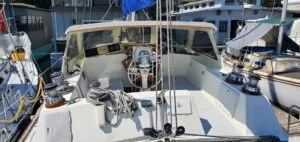
CHOICES NARROWED
Now to find a suitable boat. Searching different sites turned up a number of possibilities. The issue was to find a boat that I could look at. It seemed that once I found a potential candidate, it would be sold before I could schedule a trip to visit and examine her. Yeah, this was during the COVID boat buying boom. But one of the boats that came up within my search criteria was the Cal 2-46. That really looked like what I was looking for. Large master cabin with a double berth aft, double V-berth forward with an additional single berth, a decent galley, a huge saloon amidships, and a real engine room with workspace!! She seemed to be designed with me in mind. At 46-feet long, she was a bit larger than what I had been planning on, but the layout looked great.
Now the challenge was to find a boat that I could look at to see if it would actually fit me. Now it seemed that Neptune was against me. I would find a candidate, but it would be sold before I could go look at her. I lost track of how many boats I found that were gone before I could schedule a visit—the west coast, east coast, Hawaii … whatever. Finally, one came up on the listings that was available, and the broker said they didn’t have an offer. So, I made the trip up to look her over.
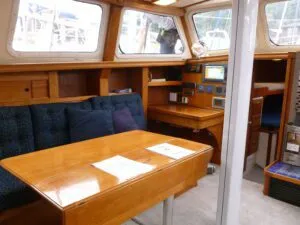
Frankly, once I stepped on the boat, I knew it was a really good choice for me. Not just the stand-up headroom front to back and the dedicated workspace/engine room. It just felt right. The broker had me look at several other boats in the same range while I was there. Some were very nice. Swan, Baltic, Tayana… They did have a Brewer aluminum hull that was VERY well equipped for offshore but was way too small. The others had way too many “warts” for me to consider. So, I scheduled a rigging survey and a boat survey. I can definitely recommend having the surveys done separately, as they involve different areas of expertise. She is also very well set up for single-handed sailing in that most of the control lines are led to the cockpit. Main and jib halyards, boom vang, outhaul and reefing lines are led to a winch on the cabin top. The primary and secondary sheet winches are also convenient to the helm position, as is the mainsheet winch. The spinnaker and secondary main and jib halyards are all on the mast but do have their own winches up there.
So now I am the proud owner of a Cal 2-46. The surveys did give me a bit of leverage to work the price down, but did I pay too much? Probably. But would the boat still be available? Probably not, given my history of having interesting boats snatched up off the market. Is the Cal a real blue-water boat? And the answer is unequivocally yes!
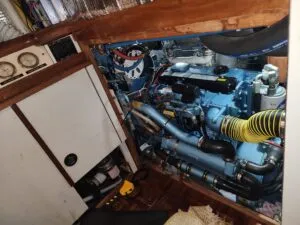
SUPERIOR OFFSHORE SAFETY
I really didn’t pay much attention to the characteristics of what was needed in a blue-water boat when I started my search, but I have learned what is important. I now pay attention to a couple of figures when evaluating boats. One is the capsize screening formula. This is a calculation regarding the ability of a boat to self-right in the case of a knockdown. The other is the comfort ratio, which gives relative stability in the presence of rough seas. As a reference, most offshore races don’t allow boats to enter with a capsize screening formula over 2.0. Now, there are many boats that have made extensive passages with numbers above that, but there is a risk. The comfort ratio is more subjective and not really a concern for racers, but that is where the heavier boats shine.
I would like to claim that I knew all about these ratios and formulas when I was looking for a boat, but that is the knowledge I acquired after the fact. But, when you start digging in, you see that the Beneteaus, Jeanneaus and the like are suitable for coastal cruising and suitable for the charter market in the Caribbean and the Med. Frankly, I recommend checking out the specs on Sailboatdata.com on any boat you are looking at for the type of sailing you are looking to do.
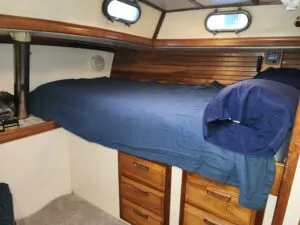
In general, heavy, long keel boats are more comfortable, but there are downsides as well. In general, they like to go in a straight line. Turning is an effort. And they can be a handful maneuvering in tight quarters.
So, let’s get to the positives and negatives of the Cal 2-46. Yeah, even though I love the Cal I have, there are things I think could be better. And, so there is no doubt about it, better means more money.
TOP 5 REASONS I LIKE MY CAL 2-46
- It is a comfortable boat. It’s big enough inside and has enough ballast to be stable in most conditions. With a comfort ratio over 40 it is one of the more stable sailing yachts available. Keep in mind that this ratio pertains to sailing in rough seas, and not handling a rolly anchorage.
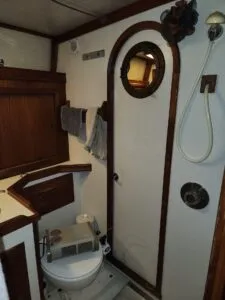
- The offshore stability is great, with a capsize screening formula of 1.6. This demonstrates a great ability to recover from a knockdown. The Cal compares favorably in this respect with other blue-water boats, such as the Island Packets or Krakens of similar size.
- Stand-up headroom. This boat has full stand-up headroom from the V-berth forward to the aft stateroom for a 6-foot plus person. Trust me, having to hunch over when walking through your boat gets old fast.
- Dedicated workroom/engine room for necessary engine and other maintenance activities while underway. This space offers a full workbench and open access to the engine and a lot of other things like filters and water pumps.
- Plenty of capacity. At least the one I purchased makes provision for 300 gallons of diesel fuel, 300 gallons of fresh water and a 100-gallon black water holding tank. So, I have close to a 2000-mile range under power alone.
TOP FIVE REASONS THE CAL 2-26 IS LESS THAN IDEAL
- It’s a heavy, long-keel boat. This means it is difficult to maneuver in tight areas. Like coming into a slip, especially with wind and current. The marina where I currently have her has significant current, so I’m reminded of this every time I go in or out. You are not going to spin this boat on a dime with rudder alone. You need to go out and practice slow-speed maneuvering under power using prop walk and wash. You especially need to know how much cross breeze will negate your prop walk.
- Also, as a long-keel boat, she really doesn’t like to go backward, which makes Med-style mooring a challenge. You can get her track in reverse if you have 2 knots of way on, but that also means you need to be able to stop that 30,000 pounds before you hit the dock.
- The sloop-rig version of the Cal 2-46 is rather underpowered relative to the size of the boat. You generally won’t be the first boat to the anchorage when traveling in a group. However, this also can mean she can handle higher winds. I did get a bit lucky on the boat I acquired. The previous owner replaced the mast with one that was 3-feet higher, which brought the sail area to displacement ratio up to a decent level. This might be less of an issue if you happen to get one of the ketch versions, but I never did see one of them listed during my 2-year search.
- The rudder is an unprotected spade. A lot of long keel boats have the rudder attached at the back side of the keel which provides substantial protection but does limit the effectiveness when turning. Other long-keel boats mount the rudder to a skeg to provide some protection. The Cal has neither, so that is one thing you need to be cognizant of when sailing through areas with debris, etc.
- The high freeboard and center cockpit design really make it difficult to pick up a mooring, especially single-handed. Maybe I’m being picky but picking up the mooring ball chain about 6 feet up forward to run the lines through is a workout. One of the alternatives I have taught some fellow sailors is to pick up the mooring off the stern. I the case of the Cal 2-46 that would save about a foot or so on the lift, but with the center cockpit design, it is still a bit of a hike to get from the helm to the stern. Basically, I provide entertainment for nearby boats when I pick up a mooring single-handed with wind and current.
One additional item that could go in both the plus and the minus columns is the huge window area in the saloon. This makes the saloon extremely bright and open. However, having the large window area as opposed to more normal portlights means you must be cognizant of large, breaking seas.
The bottom line is I’m very happy with my purchase of this Cal 2-46. I got lucky in that the previous owners treated her well. An added bonus: I got to discover the Pacific Northwest. The Puget Sound and the San Juan Islands. Fabulous!!







































Your faulty program leaves me stranded every time I try to continue an article. Get your act together or get a real job. This is really unacceptable.